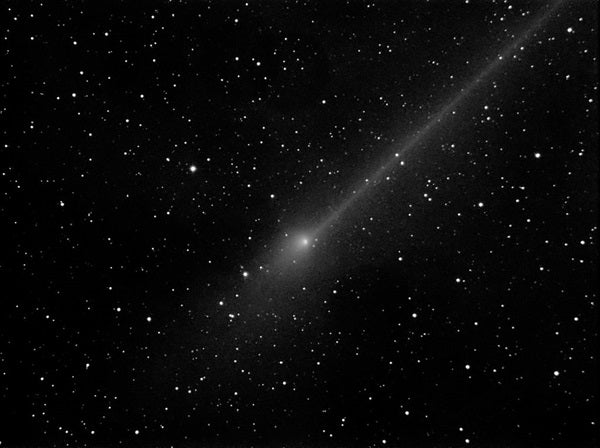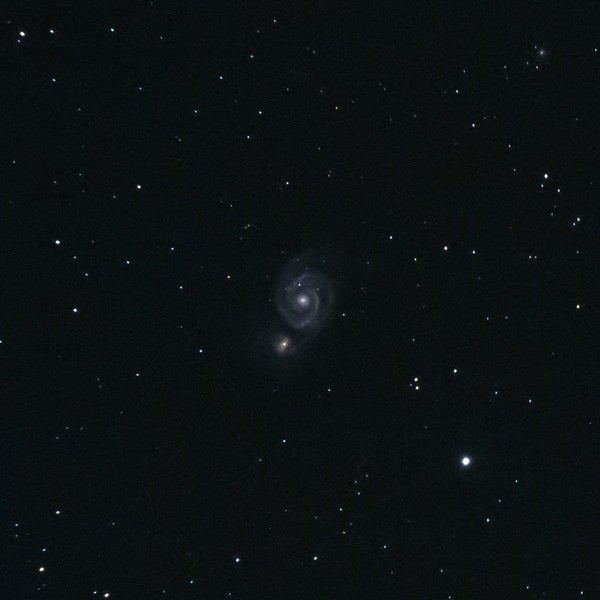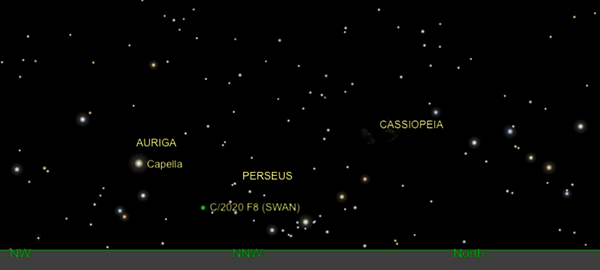Mercury passes 0.9° south of Venus at 4 A.M. EDT, although the pair are below the horizon at the time. You can catch the planets just over 1.5° apart right after sunset. They’re sinking quickly in the west-northwest, with Mercury a mere 11° high half an hour after the Sun disappears. To the planets’ upper right, you may spot the bright star Capella; to their lower left, Betelgeuse hugs the horizon.
New Moon occurs at 1:39 P.M. EDT, making the next several days an ideal time to hunt down dimmer objects that are lost in our satellite’s glare. Tonight, Comet PanSTARRS (C/2017 T2) floats near the galaxies M81 and M82 in Ursa Major. M82 is often called the Cigar Galaxy for its long, skinny shape, while M81 is a grand design spiral also known as Bode’s Galaxy.
After full dark falls, find the familiar Big Dipper asterism. From Dubhe, the star at the cup’s upper right-hand corner, look about 10.7° west to find 23 Ursae Majoris, shining at magnitude 3.7. Train your binoculars — or, better yet, a 4-inch scope (or larger) — on the area and look northeast of 23 Ursae Majoris. First you’ll hit M81, about 6.5° from the star; next comes M82, about 0.5° farther. You’ll find PanSTARRS less than 1° northeast of M82. Lower powers will show two or three of these objects at once. Larger scopes (12 inches) may reveal a hint of green in the comet’s tail.
Over the next several days, swing back to this region to follow PanSTARRs as it continues southeast. You may see it develop a “double-spiked” tail, particularly between the 24th and 26th. This occurs because as Earth passes through the comet’s orbital plane, we see the comet from a different perspective and PanSTARRS’ short, fan-shaped tail appears to flatten to edge-on. From this unique vantage point, you may see the comet’s green or blue ion and dust tail, as well as a thin, white “anti-tail” pointing in the opposite direction.

Astronomy is pleased to present The Complete Star Atlas, the perfect resource for stargazers of all ages. This practical guide to viewing the night sky includes approximately 87,000 stars, 1,200 deep-sky objects, and 24 high-quality star maps. You’ll also find 50 pages of astronomy history, tips, and more from experienced Contributing Editor Michael E. Bakich.
A 2-percent-lit Moon hangs 4.5° south of Venus half an hour after sunset. Venus itself is just 4 percent lit. Its disk, however, spans an impressive 55″. Mercury, now 3.5° east of Venus, is nearly 64 percent lit, but only 6″ across.
A few hours later, the Moon passes 4° south of Venus at 11 P.M. EDT, the closest the pair will get. By this time, however, they’ve sunk below the horizon.
With no Moon in the sky, tonight is also a good time to keep an eye out for stray Eta Aquariid meteors. Although the shower’s peak was early in the month, it’s considered active for a few more days, so you might spot a few stragglers if you’re outside for a while.
Sunday, May 24
Observers with larger scopes might want to use this time to search out the distant dwarf planet Pluto this morning. Rising higher with each hour after midnight, you’ll find the magnitude 14.7 world just 2.1° west of bright Jupiter, which is nearly magnitude –2.6. Farther east lies Saturn; the ringed world is roughly magnitude 0.5.
You’ll need clear, calm air to spot Pluto in your eyepiece, although photographic equipment should still pick it up under less-than-ideal conditions. Consider coming back to the same field several days in a row to try your luck.
The Moon passes 3° south of Mercury at 7 A.M. EDT; our satellite then passes 0.6° north of asteroid Vesta at 11 A.M. EDT. Both events, however, are hidden by daylight.
Tonight is an ideal time to hunt down some binocular objects. The constellation Boötes is a great place to start. Its bright, magnitude –0.05 alpha star, Arcturus, is visibly orange-red. From this easy-to-spot signpost, glance about 12° north to find magnitude 3.6 Rho (ρ) Boötis. Six degrees due southwest of the star is NGC 5466, a globular cluster discovered by William Herschel in 1784. It lies nearly 53,000 light-years away and glows at magnitude 9.1, covering about 11′ on the sky.
From Boötes, swing your binoculars to Canes Venatici, which houses several deep-sky objects. M3 is a magnitude 5.9 globular cluster spanning about 16′. It’s a mere 5° due west of NGC 5466. A little over 14.5° north of M3 is M63, also known as the Sunflower Galaxy. In your binoculars, this magnitude 8.6 spiral galaxy will likely appear only as a hazy star, but you can pull out a scope and crank up the power for a bit more detail.
Just under 6° to M63’s northeast is the famous Whirlpool Galaxy, listed as 51 in Messier’s catalog. Roughly the same apparent brightness and size as M63, it will appear similar in binoculars as well. This one you’ll definitely want to pull out your largest scope to see, because bigger apertures will offer a glimpse at this face-on galaxy’s delicate structure, as well as the much smaller NGC 5195, perched to the Whirlpool’s north. The two have been interacting for hundreds of millions of years, as NGC 5195 slides behind the Whirlpool.
Comet SWAN (C/2020 F8) reaches perihelion today, rounding the Sun at a distance of 37 million miles (59.5 million kilometers) from our star. Glowing around magnitude 6, the comet is an excellent binocular or small scope target in Perseus. But Northern Hemisphere observers beware: It’s already low on the northwestern horizon an hour after sunset, roughly 10° high and sinking. The comet is less than 5° above the horizon two hours after sunset, but with good seeing and a clear view all the way to the horizon, you’re likely to spot it a little over 8° due west of Capella.
Even as Comet SWAN sets, a different swan is rising: M17 (NGC 6618), also known as the Swan Nebula or the Omega Nebula in Sagittarius. Rising around 10 P.M. local time and gaining altitude with each passing hour, the Swan Nebula can be seen with binoculars or even a small scope. The star-forming region’s name comes from its resemblance to a swan gliding across a lake; can you spot the bird’s arching neck and long, feathery body?
Wednesday, May 27
Asteroid 3 Juno is stationary at 10 A.M. EDT. After today, Juno will halt its northwestern motion and make a tight turn, heading back to the southeast relative to the background stars.
Currently in the constellation Virgo, you can find Juno about 6° northwest of Auva (Delta [δ] Virginis). Juno is currently magnitude 10.7, so you’ll need large binoculars or a small scope to seek it out. Tonight, it’s just 1° northwest of the galaxy NGC 4580, a dim spiral you’ll likely need a 10-inch scope (or larger) to glimpse.
Juno is about 145 miles (234 km) in diameter. It contains roughly 1 percent of the total mass in the asteroid belt — but is only about 3 percent the total mass of Ceres, the largest body in the main belt.
Thursday, May 28
A nearly 40-percent-lit Moon sits just in front of Leo the Lion tonight. Nearby is Leo’s bright heart, Regulus, a magnitude 1.4 star whose name means “little king” in Latin. One of the brightest stars in the sky, Regulus is located almost exactly on the ecliptic, the plane of our solar system on which all the major planets orbit.
If you draw a line between the Moon and Regulus, then follow it 24.5° to the east, you’ll reach magnitude 2.1 Denebola, often drawn as the tip of the lion’s tail. Located a mere 36 light-years away, this blue-white star is more than 1.5 times as wide as the Sun and emits nearly 14 times as much light. It is also surrounded by a complex disk of cool dust, which emits light at longer, infrared wavelengths; this is the same dust from which planets are born, although there are no planets yet confirmed around this star.
Friday, May 29
Saturn’s largest moon, Titan, sits roughly 1′ due north of the ringed planet this morning. At magnitude 8.6, the moon should be the second-brightest object in your field of view (after the planet itself).
Saturn’s more distant, two-faced moon, Iapetus, is on its way toward its greatest western elongation on the 31st. Along the way, it’s growing steadily brighter, and should now be shining at nearly magnitude 10.5 almost 9′ directly west of the planet. Hyperion sits roughly one-third of the way between Saturn and Iapetus, but may be invisible at magnitude 14.
First Quarter Moon occurs tonight at 11:30 P.M. EDT.

Our exclusive Sky Guide 2020 is now available! This free downloadable pamphlet contains a month-by-month rundown of 2020’s biggest celestial events, from Mars’ best opposition in years to the return of totality in South America this December. Check out Astronomy’s Sky Guide 2020 now!












